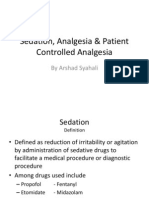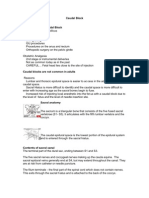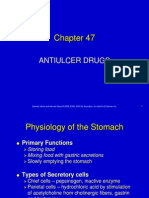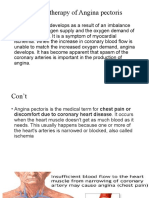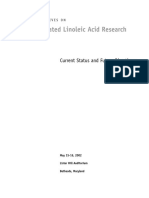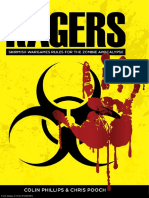Local Anaesthetics
Local Anaesthetics
Uploaded by
v_vijayakanth7656Copyright:
Available Formats
Local Anaesthetics
Local Anaesthetics
Uploaded by
v_vijayakanth7656Original Description:
Original Title
Copyright
Available Formats
Share this document
Did you find this document useful?
Is this content inappropriate?
Copyright:
Available Formats
Local Anaesthetics
Local Anaesthetics
Uploaded by
v_vijayakanth7656Copyright:
Available Formats
Topical anesthesia (surface) Infiltration Plexus block Epidural (extradural) block Spinal anesthesia (subarachnoid block)
Amides Lidocaine (Xylocaine) Bupivacaine (Marcaine) Mepivacaine (Carbocaine) Prilocaine (Citanest) Etidocaine (Duranest) Esters Procaine (Novocain) Chloroprocaine (Nesacaine) Tetracaine (Pontocaine)
The local adverse effects of anesthetic agents include neurovascular manifestations such as prolonged anesthesia (numbness) and paresthesia (tingling, feeling of "pins and needles", or strange sensations). These are symptoms of localized nerve impairment or nerve damage.
Depending on local tissue concentrations of local anesthetics there may be excitatory or depressant effects At lower concentrations, a relatively selective depression of inhibitory neurons results in cerebral excitation, which may lead to generalized convulsions.
A profound depression of brain functions occurs at higher concentrations which may lead to coma, respiratory arrest and death. Due to 1.very high plasma levels after intravenous injection of a large dose. 2. direct exposure of the central nervous system through the CSF, i.e. overdose in spinal anesthesia or accidental injection into the subarachnoid space in epidural anesthesia.
The signs and symptoms of CNS toxicity induced by local anesthetics resemble vasovagal responses. Early symptoms, such as a metallic taste, tinnitus, lightheadedness, and confusion, are followed by tremors and shivering.
The conductive system of the heart is quite sensitive to the action of local anesthetics. Lidocaine is often used as an antiarrhythmic drug and has been studied extensively, but the effects of other local anesthetics are probably similar to those of Lidocaine. Lidocaine acts by blocking sodium channels, leading to slowed conduction of impulses. This may obviously result in bradycardia, but tachyarrhythmia can also occur. With high plasma levels of lidocaine there may be higher-degree atrioventricular block and severe bradycardia, leading to coma and possibly death.
Recent case reports have been published of the successful use of lipid emulsion in this way (Rosenblatt 2006, Litz 2006, Foxall 2007) to save patients who were unresponsive to the usual resuscitation methods. All patients recovered completely shortly after intravenous injections of lipid.
20% Intralipid: 1.5 mL/kg as an initial bolus, followed by 0.25 mL/kg/min for 30-60 minutes Bolus could be repeated 1-2 times for persistent asystole Infusion rate could be increased if the BP declines.
Adverse reactions to local anesthetics (especially the esters) are not uncommon, but true allergy is very rare. Allergic reactions to the esters is usually due to a sensitivity to their metabolite, paraaminobenzoic acid (PABA), and does not result in cross-allergy to amides. There are also cases of allergy to paraben derivatives, which are often added as preservatives to local anesthetic solutions.
The pain of injection is caused by insertion of the needle and infiltration of the anesthetic into the skin. Ideally, the smallest gauge needle, usually 25 to 30, should be used to inject all anesthetics. Adjunctive techniques using topical anesthetics, cryotherapy, or distraction may complement the routine use of lidocaine. Pinching the skin stimulates local sensory nerves, partially blocking the transmission of other painful stimuli. Injecting slowly and steadily can minimize the pain of the anesthetic itself. If clinically indicated, injecting into the subcutaneous tissues is less painful than infiltrating directly into the dermis to raise a wheal. Physicians should remember that ethyl chloride is flammable and should not be used with electrocautery.
The addition of epinephrine at 1:100,000 to 200,000 (5 to 10 g per mL) is useful to prolong the duration of anesthesia and provide some degree of hemostasis. When working on highly vascular tissues such as the scalp, the physician may need to wait between injection and surgery. The onset of optimal vasoconstrictive effect from epinephrine is approximately five minutes. With the vasoconstriction and resultant delay in absorption afforded by epinephrine, the maximum recommended dose of lidocaine increases from 4 to 7 mg per kg1 (Table 23-5).
Adrenaline 1:1000 contains 1 gram of adrenaline per 1000mls solution i.e. 1mg/ml. To prepare a 1 in 200,000 solution the 1:1000 must be diluted 200 times. This is achieved by taking 0.1ml (= 0.1mg) and adding 19.9 mls of local anaesthetic solution.
Adrenaline Prilocaine Lignocaine Bupivacaine
Plain Solution mg/kg 6 3 2
With mg/kg 9 7 2
Adrenaline containing solutions should never be used for infiltration around end-arteries i.e. penis, ring block of fingers or other areas with a terminal vascular supply as the intense vasoconstriction may lead to severe ischaemia and necrosis.
[edit] Hypersensitivity/Allergy Adverse reactions to local anesthetics (especially the esters) are not uncommon, but true allergy is very rare. Allergic reactions to the esters is usually due to a sensitivity to their metabolite, para-aminobenzoic acid (PABA), and does not result in cross-allergy to amides. Therefore, amides can be used as alternatives in those patients. Non-allergic reactions may resemble allergy in their manifestations. In some cases, skin tests and provocative challenge may be necessary to establish a diagnosis of allergy. There are also cases of allergy to paraben derivatives, which are often added as preservatives to local anesthetic solutions
Methemoglobinemia The systemic toxicity of prilocaine is comparatively low, however its metabolite, otoluidine, is known to cause methemoglobinemia. As methemoglobinemia reduces the amount of hemoglobin that is available for oxygen transport, this side effect is potentially life-threatening. Therefore dose limits for prilocaine should be strictly observed. Prilocaine is not recommended for use in infants.
There are few absolute contraindications for local injection anesthetics. Allergy to amide anesthetics such as lidocaine is rare, and when it does occur, it is usually caused by the preservative methylparaben.1 One way to circumvent a potential allergic reaction is to use preservative-free lidocaine, which is available in single-dose vials. History of an allergy to an ester anesthetic such as procaine (Novocain) is not a contraindication to the use of lidocaine,1 because they are chemically different, and cross-reaction is rare (Table 1). Another approach includes using 1 percent diphenhydramine (Benadryl), which has proved effective in randomized studies.2 The addition of epinephrine, a potent vasoconstrictor, is contraindicated when it may compromise blood flow in a confined space. Epinephrine should never be used in digital and penile blocks or in skin flaps with marginal viability. The use of epinephrine in the nasal tip and ear is relatively contraindicated for the same reasons, but it has been used in studies in which the treated areas are kept warm to prevent additional vasoconstriction.3 The clinician should exercise caution when contemplating the use of vasoconstrictors in dirty wounds because of the increased risk of infection. In addition, certain patients with diabetes, hypertension, heart block, or cerebrovascular disease may be particularly sensitive to epinephrine
Local anaesthetics applied to the skin, the eye, the ear, the nose and the mouth as well as other mucous membranes. In general, cocaine, amethocaine, lignocaine and prilocaine are the most useful and effective local anaesthetics for this purpose. When used to produce topical anaesthesia, they usually have a rapid onset of action (5-10mins) and a moderate duration of action (30-60 mins). Cocaine is a potent vasoconstrictor and is useful in the reduction of bleeding as well as topical anaesthesia. Absorption of local anaesthetics through intact skin is usually slow and unreliable and high concentrations (e.g. 20% benzocaine or 40% lignocaine) are required
Amide anaesthetics with a moderate duration of action are commonly used (lignocaine, prilocaine and mepivacaine). The site of action is at unmyelinated nerve endings and onset is almost immediate. The duration of local anaesthesia is variable. Procaine has a short duration of action (15-30 min), while lignocaine, mepivacaine and prilocaine have a moderate duration of action (70-140 min). Bupivacaine has the longest duration of action (approximately 200 min). The addition of adrenaline (1 in 200,000) will increase the quality and prolong the duration of anaesthesia.
Most pure anesthetic agents exist as solids. Eutectic mixtures are liquids and melt at lower temperatures than any of their components, permitting higher concentrations of anesthetics. Eutectic mixture of local anesthetics (EMLA) represents the first major breakthrough for dermal anesthesia on intact skin. It consists of 25 mg per mL of lidocaine, 25 mg per mL of prilocaine, a thickener, an emulsifier, and distilled water adjusted to a pH level of 9.4.3
EMLA is applied in a thick layer (1 to 2 g per 10 cm2, up to a maximal dose of 10 g) to intact skin.8After application, the area is covered with a patch of Tegaderm or clear plastic wrap to facilitate penetration through the stratum corneum (Figure 1). Depth of anesthesia depends on contact time with EMLA. Anesthetic effect has been shown to reach a maximal depth of 3 mm after a 60-minute application, and 5 mm after a 120-minute application.9 It was also found that dermal analgesia continues and may even increase for 30 to 60 minutes after the cream is removed.9 EMLA should not be applied to the palms and soles because of variable penetration.
EMLA has been associated with occasional adverse reactions, including blanching and redness at the application site.8,12 Perhaps the most serious complication is methemoglobinemia. Cases of methemoglobinemia have occurred in infants younger than three months of age who were exposed to high doses of EMLA for prolonged periods.8 Since then, other studies have demonstrated that 1 g of EMLA applied to the penis for one hour is safe to use in healthy, full-term neonates before circumcision.13,14 Although using EMLA is better than using no anesthesia at all, the dorsal penile nerve block still offers superior analgesia before circumcision, and the methods may be combined.13
You might also like
- The Diet Review 39 Popular Nutrition and Weight Loss Plans and The Science or Lack of Science Behind Them Harvard HealthDocument57 pagesThe Diet Review 39 Popular Nutrition and Weight Loss Plans and The Science or Lack of Science Behind Them Harvard HealthJohnny92% (12)
- Interview Questions-PVDocument9 pagesInterview Questions-PVtausif100% (1)
- Supportive Care in Clinical ToxicologyDocument13 pagesSupportive Care in Clinical ToxicologyKausal VermaNo ratings yet
- Anticholinesterase: PHARMACOLOGY PPT by Dr. Geraldine CorporalDocument4 pagesAnticholinesterase: PHARMACOLOGY PPT by Dr. Geraldine Corporaltaco cat100% (1)
- Sedative - HypnoticsDocument60 pagesSedative - HypnoticsNurul AinNo ratings yet
- LocalanestheticsDocument51 pagesLocalanestheticskingkb4uNo ratings yet
- General PharmacologyDocument28 pagesGeneral PharmacologypradeephdNo ratings yet
- Drugs Used in The Treatment of CoughDocument12 pagesDrugs Used in The Treatment of CoughMaryam NisaNo ratings yet
- Atralex InjectionDocument20 pagesAtralex InjectionNor Zahidah100% (1)
- Adverse Drug EffectsDocument66 pagesAdverse Drug EffectsSuba Ranjana BalaNo ratings yet
- Anti-Tussives-Mucolytics-Expectorants-Feb 2015Document10 pagesAnti-Tussives-Mucolytics-Expectorants-Feb 2015Homeground entertainmentNo ratings yet
- Basic of Fluid Therapy ImaDocument69 pagesBasic of Fluid Therapy Imal Made ArtawanNo ratings yet
- Dexmedetomidine: Its Use in Intensive Care Medicine and AnaesthesiaDocument5 pagesDexmedetomidine: Its Use in Intensive Care Medicine and AnaesthesiaTarachand LalwaniNo ratings yet
- Dr. Niranjan Murthy H.L Assistant Professor Dept of Physiology SSMCDocument37 pagesDr. Niranjan Murthy H.L Assistant Professor Dept of Physiology SSMCnirilib100% (2)
- Lecture 4, 5 - Drugs Used in Bronchial Asthma & COPDDocument57 pagesLecture 4, 5 - Drugs Used in Bronchial Asthma & COPDBalakrishnan Thangaraj100% (1)
- Speaker: DR Srikanth AlladiDocument71 pagesSpeaker: DR Srikanth AlladisrikanthalladiNo ratings yet
- Uptake and Distribution of Volatile AnestheticsDocument22 pagesUptake and Distribution of Volatile AnestheticsSuresh Kumar100% (3)
- Sedation, Analgesia & Patient Controlled Analgesia 2Document28 pagesSedation, Analgesia & Patient Controlled Analgesia 2Arshad SyahaliNo ratings yet
- Caudal BlockDocument6 pagesCaudal BlockAshish PandeyNo ratings yet
- Practical 1-Far 161-FinishDocument10 pagesPractical 1-Far 161-FinishZulkifli Khairuddin100% (1)
- Anaesthesia 1Document26 pagesAnaesthesia 1Snehal SinghNo ratings yet
- Assignment AnesthesiaDocument9 pagesAssignment AnesthesiaRavi PatelNo ratings yet
- Intraoperative Fluid ManagementDocument15 pagesIntraoperative Fluid ManagementMirela Marina BlajNo ratings yet
- A Comparative Study of Phenylephrine, Ephedrine and Mephentermine For Maintainance of Arterial Pressure During Spinal Anaesthesia in Caesarean SectionDocument6 pagesA Comparative Study of Phenylephrine, Ephedrine and Mephentermine For Maintainance of Arterial Pressure During Spinal Anaesthesia in Caesarean SectionInternational Organization of Scientific Research (IOSR)No ratings yet
- Anti-Cholinergic Drugs and Cholinesterase InhibitorsDocument24 pagesAnti-Cholinergic Drugs and Cholinesterase InhibitorsKhalid I. Abdullah100% (1)
- Vasodilators: A B C D XDocument1 pageVasodilators: A B C D XPatricia Marie BuenafeNo ratings yet
- Premedicantdrugs1 170216071329Document49 pagesPremedicantdrugs1 170216071329Sagar BhardwajNo ratings yet
- Anaesthesia in Asthmatic (Read)Document39 pagesAnaesthesia in Asthmatic (Read)Parvathy R NairNo ratings yet
- Antiadrenergic DrugsDocument19 pagesAntiadrenergic DrugsshivanshpandeNo ratings yet
- Sedative Hypnotic Drugs - ArfDocument69 pagesSedative Hypnotic Drugs - Arfaditia1984No ratings yet
- Respiration 16 Respiratory FailureDocument31 pagesRespiration 16 Respiratory Failureapi-19641337No ratings yet
- Inhalational AnestheticsDocument28 pagesInhalational Anestheticskader abdiNo ratings yet
- L-19 Skeletal Muscle RelaxantDocument26 pagesL-19 Skeletal Muscle RelaxantZakiyahulfahdwNo ratings yet
- Electrolyte Replacement Guide - ICU CliniciansDocument8 pagesElectrolyte Replacement Guide - ICU Cliniciansnolan4266No ratings yet
- A Comparative Study of Clonidine and Lignocaine For Attenuating Pressor Responses To Laryngoscopy and Endotracheal Intubation in Neurosurgical CasesDocument5 pagesA Comparative Study of Clonidine and Lignocaine For Attenuating Pressor Responses To Laryngoscopy and Endotracheal Intubation in Neurosurgical Casesnethra nitinNo ratings yet
- Skeletal Muscle RelaxantsDocument12 pagesSkeletal Muscle RelaxantsKhemz Dalde LimNo ratings yet
- Skeletal Muscle RelaxantDocument37 pagesSkeletal Muscle RelaxantNicole Mae DavidNo ratings yet
- TDM of PhenytoinDocument5 pagesTDM of PhenytoinMounika16 PedamalluNo ratings yet
- ArdsDocument14 pagesArdsvarunNo ratings yet
- Pharmacokinetics Pharmacodynamics of Controlled Release SystemsDocument33 pagesPharmacokinetics Pharmacodynamics of Controlled Release SystemsSumant SainiNo ratings yet
- Acute Exacerbation of Copd & Status AsthmaticusDocument59 pagesAcute Exacerbation of Copd & Status AsthmaticusSaras SinghNo ratings yet
- NocturiaDocument10 pagesNocturiaKousik AmancharlaNo ratings yet
- Abg AnalysisDocument43 pagesAbg AnalysisHakuna MatataNo ratings yet
- Keep The Airway Open: Head-DownDocument1 pageKeep The Airway Open: Head-DownzenalNo ratings yet
- Anti Ulcer DrugsDocument25 pagesAnti Ulcer DrugsPam LalaNo ratings yet
- Non-Steroidal Anti-Inflammatory Drugs (Nsaids) : Analgesic, Anti-Pyretic and Anti-Inflammatory AgentsDocument45 pagesNon-Steroidal Anti-Inflammatory Drugs (Nsaids) : Analgesic, Anti-Pyretic and Anti-Inflammatory AgentsArvi KhanNo ratings yet
- Factors Modifying Drug Action Ppt-1Document15 pagesFactors Modifying Drug Action Ppt-1bichanga jobNo ratings yet
- 7 Pulmonary EdemaDocument10 pages7 Pulmonary Edemaomar kmr97No ratings yet
- III) Pharmacotherapy of Angina PectorisDocument23 pagesIII) Pharmacotherapy of Angina PectorisAyro Business CenterNo ratings yet
- Anatomy and Physiology of Respiratory System Relevant To AnaesthesiaDocument10 pagesAnatomy and Physiology of Respiratory System Relevant To AnaesthesiaAnonymous h0DxuJTNo ratings yet
- Drugs Used in AneasthesiaDocument73 pagesDrugs Used in AneasthesiaCabdiladif Ahmed McrfNo ratings yet
- Anti Hypertensive ThesisDocument85 pagesAnti Hypertensive Thesiskartik369No ratings yet
- Regimen VelloreDocument5 pagesRegimen Vellorefantita82100% (2)
- PHARM CARE PD SLE NewDocument58 pagesPHARM CARE PD SLE NewFishIngNo ratings yet
- Antigout DrugsDocument18 pagesAntigout Drugsmaheen aurangzaibNo ratings yet
- Inhalation Anaesthetic AgentsDocument9 pagesInhalation Anaesthetic Agentsapi-142637023No ratings yet
- Routes of Drug AdministrationDocument39 pagesRoutes of Drug AdministrationAditya AdhikariNo ratings yet
- Bronchodilator & Other Drugs Used in AsthmaDocument15 pagesBronchodilator & Other Drugs Used in AsthmaGenta JagadNo ratings yet
- Local Anesthetic Drugs: DR - Safa Bakr Karim M.B.Ch.B.,H.D.A.,F.I.B.M.S. (Anesth.)Document45 pagesLocal Anesthetic Drugs: DR - Safa Bakr Karim M.B.Ch.B.,H.D.A.,F.I.B.M.S. (Anesth.)venus jalal100% (2)
- Local AnesthesiaDocument83 pagesLocal AnesthesiaNigusseNo ratings yet
- 6 Regional AnaesthesiaDocument12 pages6 Regional AnaesthesiasaniaaNo ratings yet
- 3 PoshaDocument20 pages3 Poshav_vijayakanth7656No ratings yet
- Growing Up After Extremely Preterm Birth Lifespan Mental Health OutcomesDocument8 pagesGrowing Up After Extremely Preterm Birth Lifespan Mental Health Outcomesv_vijayakanth7656No ratings yet
- Cerebral Palsy and Developmental Coordination Disorder in Children Born PretermDocument6 pagesCerebral Palsy and Developmental Coordination Disorder in Children Born Pretermv_vijayakanth7656No ratings yet
- Bone 1Document2 pagesBone 1v_vijayakanth7656No ratings yet
- Functional Outcomes of Very Premature Infants Into AdulthoodDocument6 pagesFunctional Outcomes of Very Premature Infants Into Adulthoodv_vijayakanth7656No ratings yet
- V/Q and Oxygen: Anuja Abayadeera Part 1B AnaesthsiologyDocument42 pagesV/Q and Oxygen: Anuja Abayadeera Part 1B Anaesthsiologyv_vijayakanth7656No ratings yet
- Development MCQDocument4 pagesDevelopment MCQv_vijayakanth7656No ratings yet
- Pediatrecs EmqDocument40 pagesPediatrecs Emqv_vijayakanth7656No ratings yet
- Development 07HB29: Dominant 20Document2 pagesDevelopment 07HB29: Dominant 20v_vijayakanth7656No ratings yet
- Fetal Macro So MiaDocument2 pagesFetal Macro So Miaapi-3712326No ratings yet
- Age Group HT Cross TabulationDocument7 pagesAge Group HT Cross Tabulationv_vijayakanth7656No ratings yet
- Seminars in Pediatric Surgery Volume 21 Issue 1 2012 (Doi 10.1053/j.sempedsurg.2011.10.001) Robert C. Shamberger - Preface PDFDocument1 pageSeminars in Pediatric Surgery Volume 21 Issue 1 2012 (Doi 10.1053/j.sempedsurg.2011.10.001) Robert C. Shamberger - Preface PDFv_vijayakanth7656No ratings yet
- Inferior Vena CavalDocument6 pagesInferior Vena Cavalv_vijayakanth7656No ratings yet
- Renal FailureDocument6 pagesRenal Failurev_vijayakanth7656No ratings yet
- Ebola Virus DiseaseDocument4 pagesEbola Virus Diseasev_vijayakanth7656No ratings yet
- Chronic Restrictive Lung DiseaseDocument20 pagesChronic Restrictive Lung Diseasev_vijayakanth7656No ratings yet
- Current Practice - Diabetic Ketoacidosis in ChildrenDocument10 pagesCurrent Practice - Diabetic Ketoacidosis in Childrenv_vijayakanth7656No ratings yet
- Chronic Obstructive Pulmonary DiseaseDocument23 pagesChronic Obstructive Pulmonary Diseasev_vijayakanth7656No ratings yet
- Safety of Colloidal Silver Life Water As PDFDocument5 pagesSafety of Colloidal Silver Life Water As PDFJoaoEnriqueNo ratings yet
- Effectiveness of Maitland vs. Mulligan Mobilization Techniques in (Ingles)Document4 pagesEffectiveness of Maitland vs. Mulligan Mobilization Techniques in (Ingles)mauricio castroNo ratings yet
- Musculoskeletal Problems During Pregnancy 9259Document3 pagesMusculoskeletal Problems During Pregnancy 9259Iqra AzizNo ratings yet
- Sample Doc6Document24 pagesSample Doc6PtamenNo ratings yet
- Cla PDFDocument50 pagesCla PDFRenato NoalNo ratings yet
- How To Interpret Thyroid Function TestsDocument5 pagesHow To Interpret Thyroid Function TestsnonieshzNo ratings yet
- Poloxamer 182Document5 pagesPoloxamer 182Anonymous 9lckaf9st6No ratings yet
- 6 CVS RegulationDocument55 pages6 CVS RegulationDisha SuvarnaNo ratings yet
- Bahan Responsi English 2020 WORDDocument102 pagesBahan Responsi English 2020 WORDGilang KencanaNo ratings yet
- Elective 2 Lecture 1 Concept of IllnessDocument9 pagesElective 2 Lecture 1 Concept of IllnessMelchor Felipe Salvosa100% (1)
- ENGLISH 6 Summative TestDocument2 pagesENGLISH 6 Summative TestBencea CoronadoNo ratings yet
- Mentalhealth 220307112721Document26 pagesMentalhealth 220307112721sainilNo ratings yet
- MDWF 2060 Carter 2Document6 pagesMDWF 2060 Carter 2api-366292665No ratings yet
- Megaloblastic Anemia: A Case StudyDocument30 pagesMegaloblastic Anemia: A Case Studyromeo rivera100% (3)
- Toxic Effects of DrugsDocument6 pagesToxic Effects of DrugsBern NerquitNo ratings yet
- Health Teaching On Influenza A (H1N1) Swine FluDocument4 pagesHealth Teaching On Influenza A (H1N1) Swine FluPmoigkiNo ratings yet
- Rager Low ResDocument210 pagesRager Low ResFrank Magaw100% (1)
- Aot 70 119Document23 pagesAot 70 119NataliaNo ratings yet
- Signs of Vitamin b12 DeficiencyDocument9 pagesSigns of Vitamin b12 DeficiencyMark JonesNo ratings yet
- Drug Study Tramadol HydrochlorideDocument1 pageDrug Study Tramadol HydrochlorideSEAN PATRICK SILADANNo ratings yet
- Dr. Kristia Hermawan, MSC, Sp.A: Pediatric Nephrology Sub-DivisionDocument47 pagesDr. Kristia Hermawan, MSC, Sp.A: Pediatric Nephrology Sub-DivisionWindy MentariNo ratings yet
- Family Coping IndexDocument5 pagesFamily Coping IndexJohn Patrick CuencoNo ratings yet
- Holistic Assessment ToolDocument56 pagesHolistic Assessment TooltisoysombrioNo ratings yet
- Two Year Old May Have Killed BabyDocument3 pagesTwo Year Old May Have Killed Babyapi-3750354No ratings yet
- Cassava Catalogue 2016 3rd RevisionDocument62 pagesCassava Catalogue 2016 3rd RevisionDestin Iragi ziringaboNo ratings yet
- Diabetes ManagementDocument9 pagesDiabetes ManagementdhearawrsNo ratings yet
- Ec/irbDocument28 pagesEc/irbRachana ShettyNo ratings yet
- Herbal MedicineDocument11 pagesHerbal MedicineTweetie Borja DapogNo ratings yet

















